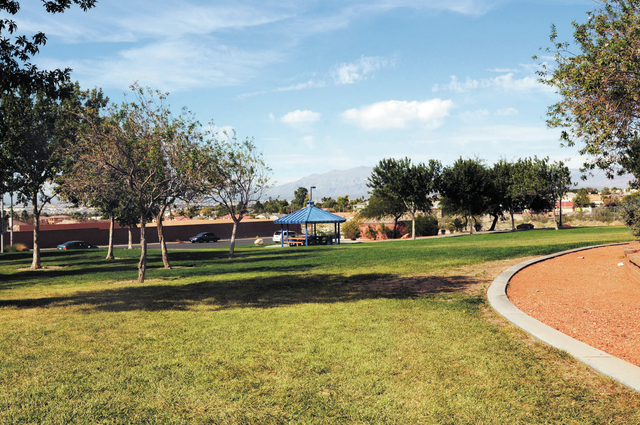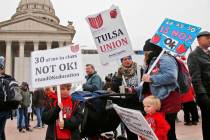Cesar Chavez spent life fighting for farm workers’ civil rights
Surrounded by views of the Strip and Frenchman Mountain, Cesar E. Chavez Park, 1450 Radwick Drive, overlooks the city in a distinct way. The park was named for a man who fought for civil rights through peaceful means and offers a sanctuary to those looking to relax in a mostly quiet neighborhood.
Mindy Meyers, manager of the city Parks and Recreation Department, said the estimated $1.2 million park was completed in 2002, under the name O’Callaghan School Park, named for former Nevada Gov. Donal Neil “Mike” O’Callaghan. A few months later, the name changed.
“Former Gov. O’Callaghan wanted Mr. Chavez’s efforts for migrant workers to be recognized and remembered through naming a public facility after him,” Meyers said.
The 5-acre park, which adjoins O’Callaghan Middle School, includes playgrounds, picnic areas, basketball courts, fitness courses and walking trails.
“(My friends and I) like coming here to have lunch or just to hang out,” said resident Sabrina Summers, 17. “The park has a gorgeous view of the city. Sometimes, we even play baseball at 2 in the morning. It’s a safe neighborhood.”
Meyers said that normally, parks adjacent to schools are named for the affiliated schools for easy identification and to make them more locatable. However, the Board of County Commissioners received a request from O’Callaghan, who asked that the county name the park for Cesar Chavez.
The county honored this request and renamed the park Cesar E. Chavez Park on April 2, 2002.
O’Callaghan died of a heart attack on March 5, 2004, at age 74.
A Las Vegas Review-Journal story in September 1999 said that O’Callaghan grew up at a farm that his parents lost during in the Depression, which caused them to take up marginal land in Wisconsin.
O’Callaghan went on to serve eight years as governor of Nevada, beginning in 1971. During his terms, O’Callaghan fought for the Equal Rights Amendment and appointed women to positions of authority.
Similarly to O’Callaghan, Cesar Estrada Chavez fought for equal rights after experiencing hardships. Chavez went on became a hero of Southwestern farm workers.
In a March 2002 Las Vegas Sun column, O’Callaghan wrote, “Chavez, by his own sacrifices, gave hope to the field workers … This nonviolent leader held up Jesus Christ, Martin Luther King Jr. and Gandhi as his heroes. His power came from leading by example and never expecting his followers to do anything he was unwilling to do.”
Chavez was born on March 31, 1927, according to the United Farm Workers website, ufw.org. He grew up in Arizona, where he witnessed his father being cheated out of his land.
In 1938, he and his family moved to California, where they worked hard in the dangerous fields of California, from Brawley to Oxnard, Atascadero, Gonzales, King City, Salinas, McFarland, Delano, Wasco, Selma, Kingsburg and Mendota.
As a child, Chavez experienced segregation and racism at school, where his spark to fight against injustice only grew.
In 1946, at age 19, Chavez joined the U.S. Navy, which was then segregated, and served for two years. He married Helen Fabela in 1948 and settled in Delano, Calif., where he started his family.
Chavez worked in the fields until 1952, when he became involved with a Latino civil rights group called the Community Service Organization. Chavez was hired and trained as an organizer targeting police brutality. He was trained by a man who later became his mentor, Fred Ross. Chavez also took on the task of urging Mexican Americans to register and vote.
Chavez founded the National Farm Workers Association, which later became the United Farm Workers in 1962. Dolores Huerta, a Chicana feminist and activist, joined him, and the union was born.
Richard Chavez, Chavez’s brother, designed the Aztec squared-shaped eagle that represents the UFW. The red and black colors and the bold design symbolized courage, dignity and pride for Chavez and the union workers.
Chavez spent the rest of his life protesting for higher wages, as many of the farm workers were paid less than $1 an hour, according to the website. Farm workers were also infested with toxic pesticides and had to withstand long hours of working under the hot sun. The website added that the average life expectancy of a farm worker was 49 years.
Chavez gained attention through fasting, boycotts and by being outspoken. He put a face to the injustices that farm workers faced and helped restore dignity and fair wages.
One of the more notable accomplishments of the union was the passage of the California Agricultural Labor Relations Act, which gave collective bargaining rights to farm workers.
After spending a lifetime of fighting, Chavez died in his sleep on April 23, 1993.
“My father said I already have a park named after our family, so why don’t you name it after somebody who has a connection to community?” said Deacon Tim O’Callaghan, son of Mike O’Callaghan. “He really cared about the human dignity of workers and how they were treated.”
Contact Sunrise/Whitney View reporter Sandy Lopez at slopez@viewnews.com or 702-383-4686.















